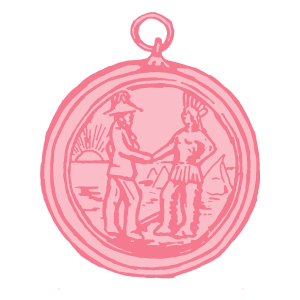The Intent of Treaties

The traditions and protocols of Indigenous treaties existed long before first contact with Europeans. Indigenous people had engaged in their own forms of governance for hundreds of years; sharing resources and building alliances between nations. For First Nations people, treaties are considered sacred. To honour their sacredness, protocols and negotiations involved ceremonial aspects such as a pipe ceremony or an exchange of symbolic items.
Treaties were commonly signified and symbolized in the making of a wampum belt out of purple or black quahog clam shells and white whelk shells. Given the belief in the sacredness of all things associated with the land and that spirit is alive in everything, the shells themselves are able to hold the intent of the treaties and pass them from generation to generation. For further information about the significance of wampum, see Wampum holds power of earliest agreements.
The peaceful and harmonious alliances between Indigenous groups that were formed hundreds of years ago still exist today. One of the most well-known examples of this is the Haudenosaunee Confederacy (also known as Six Nations or Iroquois Confederacy) and is considered the first democracy. The Haudenosaunee includes Mohawk, Oneida, Onondaga, Cayuga, and Seneca, and later included Tuscarora. There is also the Three Fires Confederacy beginning in the 1600s that is made up of Ojibway, Potawatomi, and Odawa nations. The Wabanaki Confederacy dates as far back as the 1680s and includes the Mi’kmaq, Wolastoqey, Peskotomuhkatiyik, Abenaki, and Penobscot.
The Dish with One Spoon treaty between the Anishinaabe, Mississaugas, and Haudenosaunee nations living around the Great Lakes is an example of the spirit and intent in which First Nations would have entered into treaty agreements with Europeans. The sharing of resources for the sustenance of all in a spirit of peace and friendship was at the foundation of the treaty process from a First Nations perspective.
During early contact with Europeans, First Nations began negotiating peaceful co-existence with the newcomers. A well-known example of this is the Two-Row Wampum between the Haudenosaunee and the Dutch that would ensure friendship, peace, and respect for as long as the sun shines, the grass grows, and the rivers flow. Indigenous groups across Turtle Island were familiar with the process of negotiation and treaty-making by the time of European contact; however, they were not prepared for the different approaches to the treaty process that Europeans would bring.


